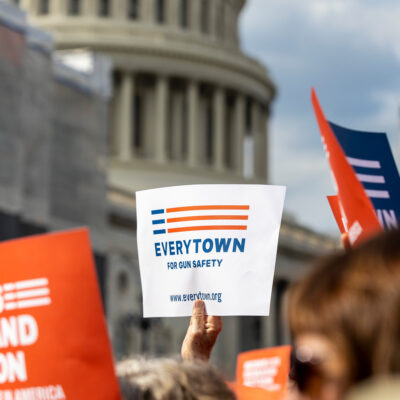New Report: Unannounced Active Shooter Drills Have No Place in Our Schools
2.11.2020
Everytown for Gun Safety Support Fund, American Federation of Teachers, and National Education Association Release Recommendations on Active Shooter Drills and Proactive School Safety Solutions
Companies like ALICE Training Institute Promote Extreme Drills That Are Not Supported by Research
NEW YORK — Today, Everytown for Gun Safety Support Fund (Everytown), the American Federation of Teachers, and the National Education Association released a new report about the impact and efficacy of active shooter drills. The report recommends that schools refrain from conducting active shooter drills that are unannounced, as well as a prohibition on drills that simulate gun violence, such as ALICE drills. It also includes guidelines and best practices for schools that choose to drill students about active shooters.
“Students at my school have to go through a drill to practice for a shooting — even though we have already experienced the reality of one,” said Sari Kaufman, a survivor of the shooting at Marjory Stoneman Douglas High School in Parkland, a senior at Marjory Stoneman Douglas and a member of the Students Demand Action national advisory board. “Unannounced drills are harmful and misguided. And when schools focus solely on drills, it takes their attention away from the real solutions to gun violence in schools, like keeping all firearms in the home secured and passing red flag laws.”
“When I talk to parents across the country about gun safety, the topic of active shooter drills and how they are negatively impacting their children is a top concern,” said Shannon Watts, founder of Moms Demand Action. “As parents, we should refuse to accept extreme and unannounced drills as the new normal for our children. As volunteers, we will work to keep our schools safe without traumatizing our children in the process.”
“It’s now clear that unannounced active shooter drills are scaring America’s students without making them any safer,” said John Feinblatt, president of Everytown. “We need to listen to the experts and focus on addressing gun violence before it begins, rather than subjecting our kids to counterproductive drills.”
“Our students are already experiencing record levels of trauma and anxiety – first, because of the threat of shootings in schools, and now with the way these active shooter drills have been done,” said Randi Weingarten, president of the American Federation of Teachers. “Our focus must always be on what will make our public schools safe and welcoming environments for our students who attend and staff who educate them. That starts with commonsense interventions that make schools safe sanctuaries, which includes an assessment of how active shooter drills affect young minds, and a commitment to making sure they are trauma-informed, planned, age-appropriate and hopefully, a practice for educator preparedness, not a source of student distress. If we can invest in the social and emotional well-being of students and enact the necessary gun safety reforms to reduce school-based gun violence overall, we might get back to a world where active shooter drills have no place in our schools at all.”
“As educators, ensuring our students’ safety and well-being is our number one priority,” said Lily Eskelsen García, president of the National Education Association. “So traumatizing students as we work to keep students safe from gun violence is not the answer. Everywhere I travel, I hear from parents and educators about active shooter drills terrifying students, leaving them unable to concentrate in the classroom and unable to sleep at night. That is why if schools are going to do drills, they need to take steps to ensure the drills do more good than harm. And the fact that we’re focusing on these drills at all is a failure of the Administration and Senate take any meaningful steps to address the fact that too many very dangerous people have very easy access to very dangerous weapons by passing common-sense measures to keep guns away from people who shouldn’t have them.”
The report includes an analysis of the research available on active shooter drills and recommends six important stipulations for schools that conduct drills:
- Drills should not include simulations that mimic an actual incident;
- Parents should have advance notice of drills;
- Drills should be announced to students and educators prior to the start;
- Schools should create age and developmentally appropriate drill content with the involvement of school personnel, including school-based mental health professionals;
- Schools should couple drills with trauma-informed approaches to address students and educators well-being; and
- Track information about the efficacy and effects of drills.
Drills involving students should not be the only plan to respond to school shootings. The three groups released the report in conjunction with an updated version of Keeping Our Schools Safe: A Plan to Stop Mass Shootings and End All Gun Violence in American Schools, a report that provides that facts about gun violence in schools and recommends clear guidance for schools and lawmakers to intervene before gun violence in schools can occur. Recommendations include the following.
Passing gun safety laws at the state level:
- Extreme risk laws, sometimes known as red flag laws, that empower family members and law enforcement to get a court order to temporarily prevent access to firearms by students or others who are shown to be a threat to themselves, others or schools.
- Secure gun storage laws to address the most common source of guns used in school shootings.
- Requiring background checks on all gun sales so people exhibiting warning signs, minors, and people with dangerous histories can’t evade our gun laws and get their hands on guns.
- Raising the age to purchase semiautomatic firearms to 21.
Interventions at the local level:
- Public awareness campaigns about secure gun storage and extreme risk laws like the Everytown-developed programs Be SMART and One Thing You Can Do.
- Implementing an evidence-based threat assessment program, such as the Comprehensive Student Threat Assessment Guidelines, to empower a school-based multidisciplinary team to assess the risk and appropriately intervene (including using extreme risk laws) without overly relying on discipline or the criminal justice system but through expanding access to mental health services in schools.
- Implementing physical security upgrades to prevent access to schools and classrooms through access control and internal door locks.
- Emergency planning so administrators or staff can immediately lockdown schools and law enforcement can respond quickly without traumatizing students through extreme drills.
- Establishing safe and equitable schools by building effective partnerships between staff and students, reviewing discipline practices, tracking data to ensure threat assessment programs do not disproportionately impact students of color and students with disabilities, and considering utilizing a community school model.




